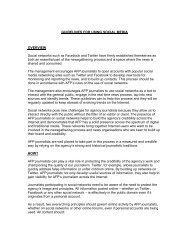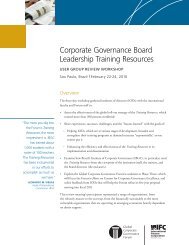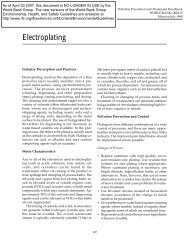SME Finance Policy Guide
SME Finance Policy Guide
SME Finance Policy Guide
Create successful ePaper yourself
Turn your PDF publications into a flip-book with our unique Google optimized e-Paper software.
G-20 <strong>SME</strong> FINANCE POLICY GUIDE<br />
25<br />
Best Practice: Coherence between competition policy and regulatory policy<br />
Close collaboration is recommended between the regulator (in charge of financial stability and prudential regulation<br />
and supervision) and the competition authority (in charge of keeping the market competitive).<br />
• •First, regulatory requirements and competition policy need to be coordinated.<br />
• •Second, a protocol for cooperation between the regulator and the competition authority should be developed.<br />
This is particularly important in crises. The competition authority can commit to addressing too-big-to-fail problems<br />
that lead to competition distortions; the regulator can address the too-big-to-fail issue and moral hazard through<br />
systemic capital charges, effective resolution procedures, and restrictions on the scope of banking activities that<br />
target conflicts of interest.<br />
• •Finally, crisis procedures should be established that define liquidity help from recapitalization and conditions for<br />
restructuring to avoid competitive distortions. Entities close to insolvency should be tightly regulated (and activities<br />
restricted) in a framework permitting prompt corrective action.”<br />
Source: Vives (2010)<br />
developing countries will also be subject to more stringent<br />
capital requirements (with greater reliance on<br />
core tier capital), leverage ratios, and other rules being<br />
proposed at the international level by the BCBS. This<br />
should not pose an immediate problem, as emerging<br />
country banks are generally better capitalized and less<br />
leveraged than banks in developed countries, but these<br />
banks will need to build up more capital in order to<br />
meet the growing needs of their economies, including<br />
the demand for credit by <strong>SME</strong>s. Emerging country<br />
banks will also need to strengthen their risk governance<br />
in line with the more stringent standards being<br />
currently proposed by the BCBS.<br />
Financial sector liberalization and banking regulations<br />
that allow the entry of sound and efficient banks<br />
(both foreign and domestic) and promote market<br />
competition may reduce margins and interest rate<br />
spreads. Such changes may also promote dynamism<br />
within the banking sector, as providers facing tough<br />
competition from new entrants seek new markets,<br />
and can further encourage local banks to look beyond<br />
traditional business lines, incentivizing them to<br />
develop <strong>SME</strong> banking. At a national level, openness to<br />
foreign banks may serve to increase access to capital,<br />
although it may also increase the risk of contagion<br />
from financial crises originating elsewhere, thus<br />
reinforcing the need for a sound regulatory<br />
framework. The 1989 World Development Report<br />
provides a summary of sequencing strategies that<br />
should be followed in liberalizing financial sectors,<br />
in order to minimize the risk of instability.<br />
Challenges and priorities for LDCs<br />
In smaller and/or lower income countries, policymakers<br />
seeking to stimulate greater competition may only<br />
have access to a limited range of effective tools.<br />
Research on competition that targets developed countries<br />
suggests that a liberal entry policy vis-à-vis reputable<br />
financial service providers can help. Also of use<br />
are transparency of product pricing and the compulsory<br />
sharing of credit information, and rules about<br />
network access and interoperability of networks in the<br />
retail payments system. However, the latter may not be<br />
fully effective, since the applicability to developing<br />
countries of lessons learned in advanced economies is<br />
not straightforward.<br />
C.2. Financial Infrastructure<br />
Financial infrastructure as defined here includes<br />
accounting and auditing standards, credit reporting<br />
systems (credit registries and bureaus), collateral and<br />
insolvency regimes, and payments and settlement<br />
system. Financial infrastructure reduces the














![Print a two-page fact sheet on this project [PDF] - IFC](https://img.yumpu.com/43449799/1/190x245/print-a-two-page-fact-sheet-on-this-project-pdf-ifc.jpg?quality=85)


